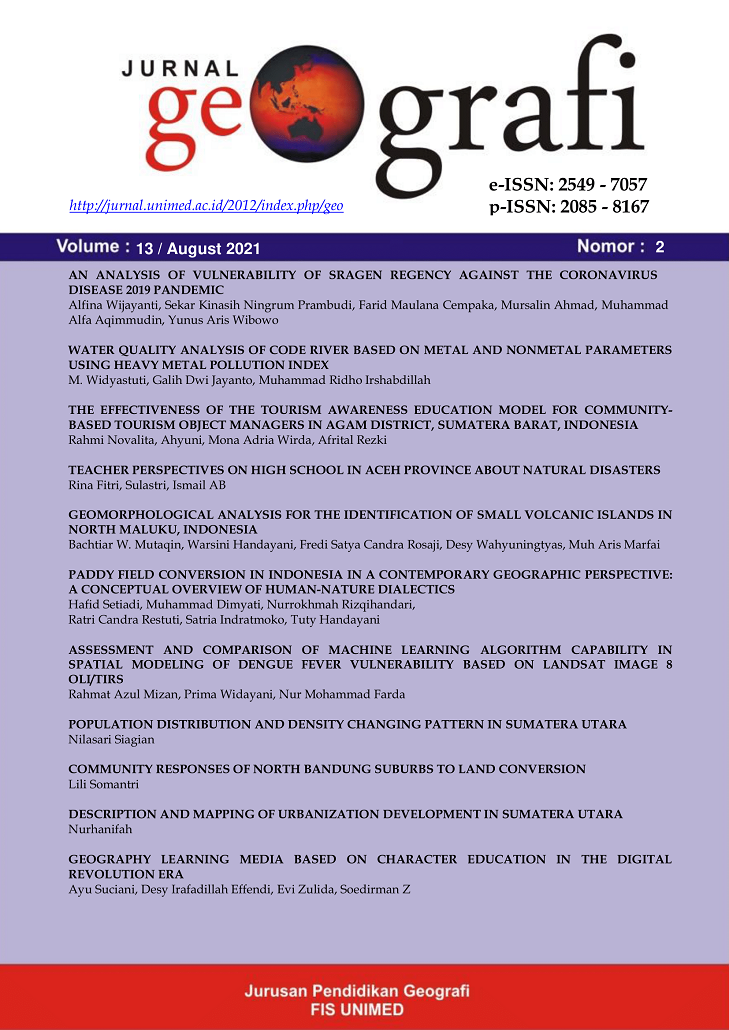TEACHER PERSPECTIVES ON HIGH SCHOOL IN ACEH PROVINCE ABOUT NATURAL DISASTERS
DOI:
https://doi.org/10.24114/jg.v13i2.23863Abstract
The Indonesian government has made efforts to restore the structure and development of school responses, including increasing knowledge, skills, and disaster management operating systems in schools. School leaders and teachers are expected to balance the need for standard operating procedures with the ability of organizational structures to respond to specific problems caused by disasters. Teacher enhancement is expected to provide a more active role for students and overcome their stress in post-disaster situations. This study aimed to examine the perspective of high school teachers on knowledge of natural disasters and natural disaster mitigation. A descriptive statistical approach is used to describe and explain teacher knowledge and mitigate natural disasters. Explaining how much influence or relationship between teachers' knowledge on disaster mitigation is done. The sample in this study was high school teachers in Aceh province, with 389 teachers. The research data collection used an instrument in the form of a questionnaire. The results showed that the perspective of high school teachers regarding knowledge of natural disasters was in the high category on average; the average teacher knew general knowledge of natural disasters, signs of catastrophe, classification of natural disasters, and causes of natural disasters. Not much different from the results of the teacher's perspective regarding natural disaster mitigation in the very high category, planning in the mitigation process, policies, operational disaster procedures, signs of disaster evacuation have been recognized by SMA teachers in Aceh province. The level of knowledge of high school teachers with mitigation has a significant relationship, so the higher the knowledge of high school teachers about natural disasters, the more high-school teachers can mitigate against natural disasters.Keywords: Teacher's Perspective, Natural Disaster Knowledge, Natural Disaster Mitigation, Regression AnalysisReferences
Adiyoso, W., & Kanegae, H. (2013). Effectiveness of disaster-based school program on students™ earthquake-preparedness. Journal of Disaster Research, 8(5), 1009-1017.
Adiyoso, W., & Kanegae, H. (2013). The preliminary study of the role of Islamic teaching in the disaster risk reduction (a qualitative case study of Banda Aceh, Indonesia). Procedia Environmental Sciences, 17, 918-927.
Alisic, E. (2012). Teachers' perspectives on providing support to children after trauma: A qualitative study. School psychology quarterly, 27(1), 51.
Arif, M., & Rosni, R. (2011). Manajemen Bencana Alam Hubungan dengan Kepuasan Publik di Daerah Bencana (Studi Didaerah Bencana di Kabupaten Mandailing Natal Provinsi Sumatera Utara). Jurnal Geografi, 3(2), 94-106.
Barus, S., & Aminah, S. (2021). Penerapan Pola Simulasi Mitigasi Bencana Alam (Gempa Bumi) Pada Guru dan Orang Tua Siswa Di Sekolah Luar Biasa. Jurnal Keperawatan BSI, 9(1), 41-48.
Bungin, B. (2007). Penelitian kuantitatif-komunikasi, Ekinomi dan Kebijakan Publik serta Ilmu Sosial lainnya. Edisi Satu. Jakarta. Prenada Media Grup.
Cvetković, V., DragiÄević, S., Petrović, M., Mijalković, S., Jakovljević, V., & GaÄić, J. (2015). Knowledge and perception of secondary school students in Belgrade about earthquakes as natural disasters. Polish journal of environmental studies, 24(4), 1553-1561.
Damanik, M. R. S., & Restu, R. (2012). Pemetaan Tingkat Risiko Banjir dan Longsor Sumatera Utara Berbasis Sistem Informasi Geografis. Jurnal Geografi, 4(1), 29-42.
Djali, N. (2013). Pendidikan Kebencanaan Di Sekolah“Sekolah Di Indonesia Berdasarkan Beberapa Sudut Pandang Disiplin Ilmu Pengetahuan. Jurnal Momentum ISSN 1693-752X, 12(1).
Erdur-Baker, Ö., KasapoÄŸlu, K., & Yılmaz, E. (2015). The objectives of disaster education from teachers™ perspectives. Journal of Human Sciences, 12(1), 975-990.
Gujarati, D. N., Bernier, B., & Bernier, B. (2004). Econométrie (pp. 17-5). Brussels: De Boeck.
Karanth, R. V. (2007). Imperatives for tsunami education. Current Science, 93(1), 8.
Karnawati, D., & Pramumijoyo, S. (2008). Strategy for promoting education for natural disaster reduction in Indonesia and ASEAN region. In B. Rouhban, & R. Shaw, The first world landslide forum (pp. 1-4).
Lei, B. Y. (2014). Teachers™ perceptions and perspectives of school disaster management over the medium term following the 2008 earthquake in Sichuan province China (Doctoral dissertation, University of Leicester).
Lekalakala, M. J. (2011). Teacher perceptions about lesson planning to include a disaster risk reduction focus. Master's thesis, Disaster Management Training and Education Centre for Africa, University of the Free State, South Africa, 156.
LIPI & UNESCO. (2010). Cerita dari Aceh: membangun kapasitas dan sekolah siaga bencana. Jakarta: LIPI & UNESCO.
Nakano, G., RamÃrez-Herrera, M. T., & Corona, N. (2019). Effects of decontextualized tsunami disaster education: A case study of schools in Acapulco, Mexico. Journal of Natural Disaster Science, 39(2), 19-33.
Nurdin, N. (2019). Disaster risk reduction in education and the secondary high school science curriculum in Indonesia (Doctoral dissertation, UCL (University College London).
Nurmayani, H. (2018). Pengaruh Organizational Silence (OS) Terhadap Organizational Citizenship Behavior (OCB) dan Dampaknya Terhadap Kinerja Badan Penanggulangan Bencana Aceh. ETD Unsyiah.
Oxfam, A. A. (2012). Analisis Kerentanan dan Kapasitas Partisipatif. Jakarta: Oxfam.
Rao, A. V., & Rao, L. G. (2007). Carotenoids and human health. Pharmacological research, 55(3), 207-216.
RI (Republik Indonesia). (2007). Undang-Undang No. 24 Tahun 2007 tentang Penanggulangan Bencana. Jakarta: Badan Nasional Penanggulangan Bencana.
Sari, S. A. (2019). Integrasi Kurikulum Kebencanaan dan Perangkat Pembelajaran dalam Meningkatkan Kompetensi Kesiapsiagaan. In TALENTA Conference Series (Vol. 2, No. 2, pp. 361-369). Universitas Sumatera Utara Selection and peer-review under responsibility of Konferensi Nasional Sosiologi VIII 2019.
Siregar, N. (2017). Implementasi Making Aceh Safer Trough Disaster Risk Reduction in Development (DRR-A) Project Oleh United Nations Development Programme (UNDP) Dalam Upaya Mengurangi Resiko Bencana di Aceh 2009-2012. Banda Aceh. eJournal Ilmu Hubungan Internasional, 5(3), 775-788.
Sumaatmadja, N. (1997). Metodologi pengajaran geografi. Jakarta: Bumi Aksara.
Wedyawati, N., Lisa, Y., & Selimayati, S. (2017). Pengaruh Model Pembelajaran IPA Terintegrasi Mitigasi Bencana Terhadap Hasil Belajar. Edukasi: Jurnal Pendidikan, 15(2), 261-273.
























